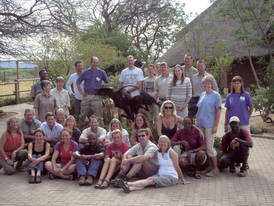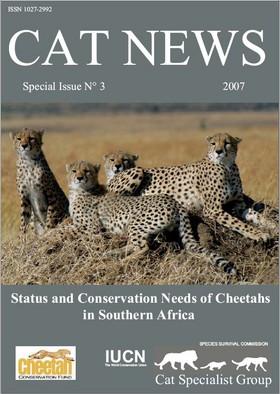Foreward

In the past few decades, the cheetah along with its habitat and prey has experienced dramatic declines throughout Africa due to human encroachment resulting in land use changes. Cheetahs are known to have one of the largest individual ranges of any terrestrial carnivore and are found to be particularly susceptible to land fragmentation. Most protected park networks are too small to conserve viable populations and larger predators (ie. lions and hyenas) are known to displace them which results in higher numbers of cheetahs living outside protected areas, placing them in increased human/wildlife conflict situations.
Cheetah conservation activities outside of protected areas have mostly taken place in the southern African region where a network of researchers and conservationists has developed. In December 2005, the Cheetah Conservation Fund in Namibia hosted the first Southern African Regional Cheetah Workshop where the idea for this special issue of Cat News was developed. The workshop brought together 32 cheetah researchers and conservationists from six countries to develop strategies to ensure cheetah survival in the 21st century. The workshop was sponsored by the Cheetah Conservation Fund (CCF), the Wildlife Conservation Network (WCN) and Classic Escapes.
This special issue of Cat News highlights the accomplishments in cheetah conservation in the southern African region over the past few years and prioritizes research and conservation objectives for the future. The compilation of current knowledge shows the needs for conservation of cheetah outside and within protected areas, discusses problems facing the cheetah due to human-predator conflict issues and reveals extension and education initiatives that have been implemented. This special issue was supported in part by the Howard Buffet Foundation, the IUCN/SSC Cat Specialist Group and the Cheetah Conservation Fund.
Collaboration and co-operation between the regional cheetah conservation organizations continues to work towards developing methodologies for their long-term studies on cheetah populations. These studies are fundamental to understanding the dynamics of the cheetah population and how it is will be affected by ongoing removals, habitat changes and conflict. Long-term data is also vital to help guide the development and implementation of management strategies aimed at ensuring the conservation of this species within and between countries in this region.
This special issue forms the basis of the Southern African Regional Conservation Strategy being compiled by regional cheetah specialists and governmental representatives in Botswana in December 2007. As with any regional strategy, the task will be to formulate conservation activities that will lead to the long-term survival of the cheetah. However, it will only be with the support of the governments and local communities that the strategy will be implemented so that the cheetah will continue to have a place under the southern African sun.
Dr. Laurie Marker
Founder/Executive Director, Cheetah Conservation Fund
Otjiwarongo, Namibia
The Namibian Cheetah: Status Report by L. Marker, A. Dickman, C. Wilkinson, B. Schumann and E. Fabiano
Over the past century, wild cheetahs have undergone a drastic reduction in global geographic range and population size, leaving Namibia as one of the remaining strongholds for the species. This report examines the distribution and population trends of cheetahs in Namibia and discusses their relative abundance on the commercial farmlands, which has led to intense conflict with humans: an issue that continues to threaten the long-term viability of the population. We provide a brief overview of the policy and legislation relevant to cheetahs in Namibia, and discuss the rates of, and reasons for cheetah removal from the farmlands, which tend to predominantly involve adult male cheetahs. Considerable research has been conducted on Namibian cheetahs, and has shown that they have extremely large home ranges, prefer habitat patches with grassy cover and high visibility, and show prey selection for native game species. In addition, extensive biomedical, reproductive and genetic research has been conducted on the Namibian cheetah providing valuable data from which conservation strategies are based. We also provide an overview of the current threats facing Namibian cheetahs, and discuss possible strategies for addressing these threats to ensure the long-term conservation of this valuable population.
Status Report for the Cheetah in Botswana by R. Klein
Historically, cheetahs Acinonyx jubatus have been distributed throughout Botswana. With once pristine habitat, very low human populations and one of the largest concentrations of ungulates on the continent, space and prey were plentiful. However, the last 40 years have seen great changes in the natural habitat, with overstocking of livestock, range partitioning, the arrival of deep borehole technology and the erection of cordon fences causing dramatic reductions in wildlife populations and the overall integrity of the Kalahari ecosystems. This report assesses current national cheetah status and distribution, detailing the factors presently affecting these populations.
The Status of the Cheetah in South Africa by K. Marnewick (coordinator), A. Beckhelling, D. Cilliers, E. Lane, M. G. Mills, K. Herring, P. Caldwell, R. Hall and S. Meintjes (contributors)
The distribution of cheetahs in South Africa appears to have increased over the past 25 years. This is due to a change in land use from cattle ranching to wildlife ranching. The largest part of the cheetah population occurs outside conservation areas on privately owned ranch land. The Kruger National Park and the Kgalagadi Transfronteir Park are the two most important conservation areas for cheetahs due to their large size and pristine habitat. The main threats to cheetahs are focused outside conservation areas and are the illegal trade, unregulated captive breeding and persecution. International trade in cheetahs is regulated by CITES and there is no quota for hunting of cheetahs. However, hunting trophies originating from the wild and captivity have been exported with CITES permits. Several programmes are in place aiming at conserving cheetah. Research is done both inside National Parks and on ranch lands. The National Cheetah Conservation Forum of South Africa (NCCF-SA) is an active forum with members from various organisations involved in cheetahs from conservation organisations, government departments, captive breeders, biologists, hunters and landowners. There is a relocation programme in place where cheetahs are relocated from ranch land to enclosed reserves to form a metapopulation. The most important steps to conserving cheetahs in South Africa have been identified as: metapopulation management, regulation and formalisation of the captive breeding industry, curbing the illegal trade, addressing persecution and conflict management and further research on cheetahs.
Supporting Online Material: Table T1 Estimated captive chetah population in South Africa Table T2. With CITES permits legally exported cheetahs Appendix I. Projects involved in cheetah conservation Appendix II. Organizations involved in cheetah conservation Appendix III. Governmental agencies responsible for cheetah Appendix IV. List of contact details for contributors to the |
Status of the Cheetah in Zimbabwe by S. Williams
The cheetah once occurred throughout Zimbabwe, but is now largely absent from the north and east of the country. Estimates of the cheetah population over the last 30 years range from 400 to 1,500, but many of these figures are not based on reliable data, and no current estimates are available. The cheetah population is thought to have been stable or decreasing in protected areas, and increasing on private land. The fast track land resettlement programme (FTLRP) initiated in 2000 may have affected the present status and distribution of the cheetah, but this has not yet been investigated. Cheetahs are legally hunted as problem animals and as trophies, but insufficient data are available to assess the impact of hunting on the population. Illegal removals may also have an important impact on the population. It is suggested that research is conducted to determine the current status and distribution of the cheetah population, and how this may have been affected by recent land use changes. In addition, it is recommended that trophy quality should be monitored, and information on non-lethal predator management techniques should be provided to farmers.
Mozambique: Preliminary Assessment of the Status and Distribution of Cheetah by G. Purchase
Historically cheetah were relatively widespread in Mozambique with records from the north, west and southern parts of the country. More recently significant populations were only known to exist in the north west corner of Tete Province, and within and on the periphery of the Limpopo Valley and Bauhine National Parks. Previous assessments of population concluded that hunting cheetahs for skins had reduced its ranged within the country, as well as a reduction in prey populations. This assessment indicates that the population of cheetahs appears to have further declined, with recent records only reported from the north west of Tete Province. However, given the historical distribution of cheetahs and the potential for the threats of poaching and reduction in prey to be alleviated there are areas where natural recolonisation may occur.
Status and Distribution of Cheetahs in Zambia: A Preliminary Assessment by G. Purchase
The historical and present day distribution of cheetah in Zambia appear to be similar, although the range has contracted. Liuwa Plains National Park, the northern section of the Kafue National Park and South Luangwa National Park still hold populations of cheetahs, although it was not possible to estimate population sizes. Cheetahs are reported from the Chimbwi plains area of the Bangwelu complex of protected areas, but sightings are infrequent. Cheetahs are also reported from the area between North and South Luangwa Parks, but appear to now be absent from the North Luangwa Park. It is not clear if cheetahs are still vagrant or extirpated in the Lower Zambezi National Park and surrounds. No data were available regarding the status of cheetahs in the remaining national parks, and in unprotected areas. The main threat to cheetahs appears to be a loss of suitable habitat and competition with humans, and a reduction in available prey. Given the reduction in range, there is an urgent need for a survey of Zambia to determine cheetah population sizes, and threats to their survival.
The Status of Cheetah in Malawi by G. & D. Purchase
Cheetah were reported as almost extinct from Malawi in 1996 and it appears that the species is now extirpated from this country mainly due to reduced habitat and prey as a result of an increased human population. Historically the cheetah was never widespread in this country due limited areas of suitable habitat and prey. Since 1980 cheetahs were only reported in three national parks along the western border with Zambia, the source of the cheetahs in Malawi. Given changes in Zambia as well as Malawi, it appears that there are no longer corridors for movement of cheetahs into Malawi, and the areas and prey base within the country cannot support viable populations.
Regional Assessment of the Status, Distribution and Conservation Needs of Cheetahs in Southern Africa by G. Purchase, L. Marker, K. Marnewick, R. Klein and S. Williams
A country by country assessment of the status, distribution and conservation needs for cheetah Acinonyx jubatus in the southern African region indicates that this area holds a significant proportion of the global population of cheetahs, at least 4 500 adults. The largest proportion of this regional population occurs in four range states, Namibia, Botswana, South Africa and Zimbabwe where it is under threat as a result of conflict with livestock and wildlife ranchers, removal of animals (both legally and illegally) for trade, loss of habitat and prey base due to an increasing human population and possible health and genetic problems. Although more information is required, it appears that cheetahs are present in the other range states, but in low numbers and disjointed populations. No information is currently available regarding threats to cheetahs in these countries.


